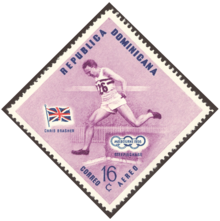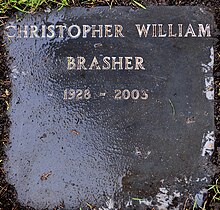Chris Brasher
 | |
| Personal information | |
|---|---|
| Born | 21 August 1928 Georgetown, British Guiana |
| Died | 28 February 2003 (aged 74) Chaddleworth, Berkshire, England |
| Occupation(s) | Athlete, sports journalist and co-founder of the London Marathon |
| Spouse | Shirley Bloomer |
Christopher William Brasher CBE (21 August 1928 – 28 February 2003) was a British track and field athlete, sports journalist and co-founder of the London Marathon.[1]
Early life and education[edit]
Born in Georgetown, British Guiana, Brasher went to Rugby School and then St John's College, Cambridge, where he read geology. He was a keen mountaineer, and as a student was president of the Cambridge University Mountaineering Club, and in 1948 led an expedition to Baffin Island with W. A. Deer.[2]
Sporting career[edit]
On 6 May 1954, he acted as pacemaker for Roger Bannister when the latter ran the first sub-four-minute mile at Iffley Road Stadium in Oxford. Brasher paced Bannister for the first two laps, while his friend Chris Chataway paced the third. Two years later, at the 1956 Summer Olympics in Melbourne, Brasher finished first in the 3,000 metres steeplechase with a time of 8 minutes 41.2 seconds, but was disqualified for allegedly interfering with another runner, Ernst Larsen of Norway. The following day, after an investigation, he was reinstated as gold medallist.[3] Brasher had been celebrating for several hours before the delayed medal ceremony, and later claimed to have been “the only Olympic champion to be totally and absolutely slaughtered when he received a medal”.[4]
He was one of the pioneers of orienteering in Britain and can claim the first public mention of the sport in an article in The Observer in 1957:
- "I have just taken part, for the first time, in one of the best sports in the world. It is hard to know what to call it. The Norwegians call it 'orientation'..."[5]
Later career[edit]
He had distinguished careers in print journalism, as sports editor for The Observer newspaper, and in broadcasting, as a reporter for the Tonight programme.
He founded Chris Brasher's Sporting Emporium in 1971; this later became Sweatshop.[6] In 1978, he designed the innovative Brasher Boot – a walking boot with the comfort of a running shoe. In their time these were amongst the best products, but declined in quality, were merged with Berghaus under Pentland ownership in 2014, and were finally discontinued before 2017.[7]
In 1981 John Disley and Brasher founded the London Marathon.[8] In 1983 he became the second president of the Association of International Marathons and Distance Races, an office which he held until 1987.[9]
Also in 1983 Brasher partnered with his longtime friend John Disley to found Fleetfoot Limited in Lancaster, England. Fleetfoot distributed The Brasher Boot and other sporting goods to retailers. Fleetfoot acquired the rights to be the UK distributor of Reebok and subsequently traded as Reebok UK before becoming a subsidiary of the Pentland Group in 1988.[10]
After the acquisition by Pentland, Brasher remained active in the company as chairman of the board. Reebok UK was sold to Reebok International in 1990 when Pentland Group sold its 55% ownership of Reebok United States and Reebok International.
Personal life and honours[edit]

Brasher married the English tennis champion Shirley Bloomer in 1959.[11]
Brasher was awarded the CBE in 1996. He was awarded the Royal Scottish Geographical Society's Livingstone Medal in 2002.[12]
In 2003, he died at his home in Chaddleworth, Berkshire, after struggling for several months against pancreatic cancer.[13]
References[edit]
- ^ John Ezard (1 March 2003). "Athletics world mourns the man behind the London marathon". Guardian Unlimited. Retrieved 22 April 2007.
- ^ Templeman, Geoffrey. "In Memoriam" (PDF). The Alpine Journal. Archived (PDF) from the original on 16 December 2022.
- ^ David Walsh (2000). "Great British Olympians:Chris Brasher". The Sunday Times. Archived from the original on 13 March 2007. Retrieved 23 April 2007.
- ^ Bryant, John (2012). "Chris Brasher, The Man Who Made The London Marathon". London: Aurum Press, Limited. p. 104.
- ^ "History of British Orienteering". Archived from the original on 10 April 2007. Retrieved 22 April 2007.
- ^ Sweatshop. "Sweatshop – About Us". Archived from the original on 20 August 2008. Retrieved 12 August 2008.
- ^ Brasher Boot Co. "About Us". Archived from the original on 4 April 2007. Retrieved 22 April 2007.
- ^ Wallechinsky, David and Jaime Loucky (2008). "Track & Field (Men): 3000-Meter Steeplechase". London: Aurum Press, Limited. p. 170.
- ^ "AIMS Executives". Association of International Marathons and Distance Races. Retrieved 29 June 2009.
- ^ "Home".
- ^ "Sports Stars Go To Altar 1959". British Pathé. Retrieved 4 February 2022.
- ^ "RSGS - Royal Scottish Geographical Society". Archived from the original on 12 February 2010. Retrieved 2010-01-29.
- ^ BBC Sport (28 February 2003). "Marathon founder Brasher dies". BBC News. Retrieved 22 April 2007.
- 1928 births
- 2003 deaths
- Sportspeople from Georgetown, Guyana
- People from Chaddleworth
- British Guiana people
- Guyanese people of British descent
- English male middle-distance runners
- British male steeplechase runners
- English male steeplechase runners
- British newspaper editors
- British sportswriters
- English male journalists
- Olympic athletes for Great Britain
- Olympic gold medallists for Great Britain
- Athletes (track and field) at the 1952 Summer Olympics
- Athletes (track and field) at the 1956 Summer Olympics
- English Olympic medallists
- Athletes (track and field) at the 1954 British Empire and Commonwealth Games
- Commonwealth Games competitors for England
- Orienteering in the United Kingdom
- Orienteering innovators
- Commanders of the Order of the British Empire
- Alumni of St John's College, Cambridge
- Medalists at the 1956 Summer Olympics
- Olympic gold medalists in athletics (track and field)
- Pacemakers
- Burials at St Peter's, Petersham
